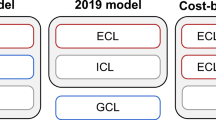Abstract
Some have argued for a common language in the field of instructional design in an effort to reduce misunderstandings and simplify a multitude of synonymous terms and concepts. Others feel that this goal is undesirable in that it precludes development and flexibility. In this article we propose an ontology-building process as a way for readers to compare and analyze terms and concepts across theories. This process entails the development of categories that emerge from the literature, and the comparison of theories across categories. Such a process can reveal broader concepts that exist beyond specific theoretical terminology, differences in meanings behind common terms used by theorists, a greater understanding of the theorists’ intent, and discontinuities and gaps within the theoretical literature.
Similar content being viewed by others
References
Barrows, H. S. (1998). The essentials of problem-based learning. Journal of Dental Education, 62(9), 630–633.
Clark, R. E. (1994). Media will never influence learning. Educational Technology Research and Development, 42(2), 21–29. doi:10.1152/advan.00094.2010.
Corcho, O., Fernández-López, M., & Gómez-Pérez, A. (2003). Methodologies, tools and languages for building ontologies. Where is their meeting point? Data Knowledge and Management, 46, 41–64. doi:10.1016/S0169-023X(02)00195-7.
Gibbons, A. S., & Bunderson, C. V. (2005). Explore, explain, design. In K. Kempf-Leonard (Ed.), Encyclopedia of social measurement (Vol. 1, pp. 927–938). Boston: Elsevier Inc.
Gibbons, A. S., & Rogers, P. C. (2009). The architecture of instructional theory. In C. M. Reigeluth & A. A. Carr-Chellman (Eds.), Instructional-design theories and models (Vol. 3, pp. 305–326). Mahwah: Lawrence Earlbaum Associates.
Glaser, B. G., & Strauss, A. (1967). The discovery of grounded theory. Chicago: Aldine.
Gruber, T. R. (1993). A translation approach to portable ontology specifications. Knowledge Acquisition, 5(2), 199–220.
Halonen, J. S. (1999). On critical thinking. In B. Perlman, L. I. McCann, & S. H. McFadden (Eds.), Lessons learned: Practical advice for the teaching of psychology (pp. 121–125). Washington D.C.: American Psychological Society.
How search works. (n.d.). Retrieved August 15, 2014, from http://www.google.com/insidesearch/howsearchworks/thestory/.
Jepsen, T. C. (2009). Just what is an ontology, anyway? IT Professional, 11, 22–27.
Jonassen, D. (1999). Designing constructivist learning environments. In C. M. Reigeluth (Ed.), Instructional-design theories and models: A new paradigm of instructional theory (Vol. 2, pp. 215–240). Mahwah: Lawrence Erlbaum Associates.
Kahneman, D. (2011). Thinking fast and slow. New York: Farrar, Straus and Giroux.
Klir, G. J. (1969). An approach to general systems theory. New York NY: Van Nostrand Reinhold Company.
McDonald, J. K. (2006). Technology I, II, and III: Criteria for understanding and improving the practice of instructional technology (Doctoral Dissertation). Retrieved from ProQuest.
Noy, N. F., & McGuinness, D. L. (2001, March). Ontology development 101: A guide to creating your first ontology. Stanford Knowledge Systems Laboratory Technical Report. Retrieved August 15, 2014, from http://www.ksl.stanford.edu/people/dlm/papers/ontology-tutorial-noy-mcguinness.pdf.
Reigeluth, C. M. (Ed.). (1983). Instructional-design theories and models: An overview of their current status (Vol. 1). Hillsdale: Lawrence Erlbaum Associates.
Reigeluth, C. M. (Ed.). (1999a). Instructional-design theories and models: A new paradigm of instructional theory (Vol. 2). Mahwah: Lawrence Erlbaum Associates.
Reigeluth, C. M. (1999b). What is instructional-design theory and how is it changing? In C. M. Reigeluth (Ed.), Instructional-design theories and models: A new paradigm of instructional theory (Vol. 2, pp. 5–29). Mahwah: Lawrence Erlbaum Associates.
Reigeluth, C. M. (1999c). The elaboration theory: Guide for scope and sequence decisions. In C. M. Reigeluth (Ed.), Instructional-design theories and models: A new paradigm of instructional theory (Vol. 2, pp. 425–454). Mahwah: Lawrence Erlbaum Associates.
Reigeluth, C. M., & Carr-Chellman, A. A. (Eds.). (2009a). Instructional-design theories and models, (Vol. 3). Mahwah: Lawrence Earlbaum Associates.
Reigeluth, C. M., & Carr-Chellman, A. A. (2009b). Preface. In C. M. Reigeluth, and A. A. Carr-Chellman, (Eds.), Instructional-design theories and models (Vol. 3, pp. xi–xii). Mahwah: Lawrence Earlbaum Associates.
Reigeluth, C. M., & Carr-Chellman, A. A. (2009c). Understanding instructional theory. In C. M. Reigeluth & A. A. Carr-Chellman (Eds.), Instructional-design theories and models (Vol. 3, pp. 3–26). Mahwah: Lawrence Earlbaum Associates.
Ryan, G. W., & Bernard, H. R. (2003). Techniques to identify themes. Field Methods, 15(1), 85–109. doi:10.1177/1525822X02239569.
Schank, R. C., Berman, T. R., & Macpherson, K. A. (1999). Learning by doing. In C. M. Reigeluth (Ed.), Instructional-design theories and models: A new paradigm of instructional theory (Vol. 2, pp. 161–182). Mahwah: Lawrence Erlbaum Associates.
Schwartz, D., Lin, X., Brophy, S., & Bransford, J. D. (1999). Toward the development of flexibly adaptive instructional designs. In C. M. Reigeluth (Ed.), Instructional-design theories and models: A new paradigm of instructional theory (Vol. 2, pp. 183–214). Mahwah: Lawrence Erlbaum Associates.
Simon, H. A. (1999). The sciences of the artificial (3rd ed.). Cambridge: MIT Press.
The Knowledge Graph (n.d.). Retrieved August 15, 2014, from http://www.google.com/insidesearch/features/search/knowledge.html.
Vincenti, W. G. (1990). What engineers know and how they know it: Analytical studies from aeronautical history. Baltimore: Johns Hopkins University Press.
Yanchar, S. C., & Gabbitas, B. W. (2011). Between eclecticism and orthodoxy in instructional design. Educational Technology Research and Development, 59, 383–398.
Yanchar, S. C., Slife, B. D., & Warne, R. (2008). Critical thinking as disciplinary practice. Review of General Psychology, 12(3), 265–281. doi:10.1037/1089-2680.12.3.265.
Author information
Authors and Affiliations
Corresponding author
Rights and permissions
About this article
Cite this article
Bostwick, J.A., Calvert, I.W., Francis, J. et al. A process for the critical analysis of instructional theory. Education Tech Research Dev 62, 571–582 (2014). https://doi.org/10.1007/s11423-014-9346-5
Published:
Issue Date:
DOI: https://doi.org/10.1007/s11423-014-9346-5




